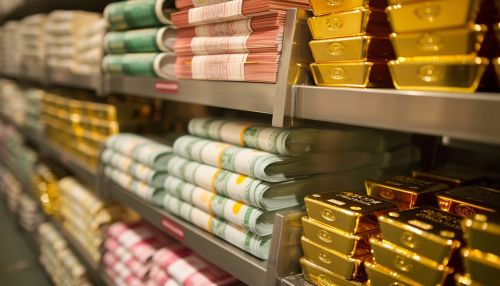Foreign Exchange Reserves
Introduction
Foreign exchange reserves, also known as forex reserves or FX reserves, are assets held by central banks and monetary authorities in various currencies. These reserves are used to back liabilities and influence monetary policy. They include foreign currencies, gold reserves, Special Drawing Rights (SDRs), and International Monetary Fund (IMF) reserve positions. The management of these reserves is crucial for maintaining the stability of a country's currency and economy.
Components of Foreign Exchange Reserves
Foreign exchange reserves typically consist of the following components:
Foreign Currencies
The most significant portion of foreign exchange reserves is held in foreign currencies. These include major currencies such as the US dollar (USD), euro (EUR), Japanese yen (JPY), British pound (GBP), and Swiss franc (CHF). Central banks hold these currencies to facilitate international trade and financial transactions.
Gold Reserves
Gold has historically been a critical component of foreign exchange reserves. Although its role has diminished over time, many central banks still hold significant quantities of gold as a hedge against inflation and currency devaluation. Gold is considered a safe-haven asset and provides diversification to the reserves portfolio.
Special Drawing Rights (SDRs)
Special Drawing Rights (SDRs) are international reserve assets created by the International Monetary Fund (IMF). They are allocated to member countries and can be exchanged for freely usable currencies. SDRs are based on a basket of major currencies, including the USD, EUR, JPY, GBP, and Chinese yuan (CNY).
IMF Reserve Positions
IMF reserve positions refer to the reserve tranche positions that countries have with the IMF. These positions represent the amount of foreign exchange that a country can draw from the IMF without conditions. They are part of a country's international reserves and provide additional liquidity.
Purposes of Holding Foreign Exchange Reserves
Foreign exchange reserves serve several critical purposes for a country's economy:
Currency Stabilization
One of the primary purposes of holding foreign exchange reserves is to stabilize the national currency. Central banks use reserves to intervene in the foreign exchange market to prevent excessive volatility and maintain a stable exchange rate. This intervention helps to build confidence in the currency and prevent speculative attacks.
Trade Facilitation
Foreign exchange reserves are essential for facilitating international trade. They provide the necessary liquidity for settling trade transactions and ensuring that importers and exporters can access foreign currencies. This is particularly important for countries with significant trade imbalances.
Debt Servicing
Countries use foreign exchange reserves to service their external debt obligations. By maintaining adequate reserves, a country can ensure that it has the necessary funds to meet its debt repayments, reducing the risk of default and maintaining creditworthiness.
Emergency Liquidity
Foreign exchange reserves act as a buffer against economic shocks and financial crises. In times of economic distress, such as a sudden capital outflow or a balance of payments crisis, reserves provide emergency liquidity to stabilize the economy and prevent a collapse in the currency.
Confidence Building
Holding substantial foreign exchange reserves can enhance investor confidence in a country's economy. It signals that the country has the financial strength to meet its international obligations and manage economic challenges. This can attract foreign investment and support economic growth.
Management of Foreign Exchange Reserves
The management of foreign exchange reserves involves several key considerations:
Diversification
Central banks diversify their reserves across different asset classes and currencies to minimize risk. Diversification helps to reduce the impact of adverse movements in any single currency or asset. The choice of assets and currencies depends on factors such as liquidity, return, and risk.
Liquidity
Liquidity is a crucial factor in reserve management. Central banks need to ensure that their reserves are readily available for intervention and crisis management. Highly liquid assets, such as government bonds and short-term deposits, are preferred for this purpose.
Safety
The safety of reserves is paramount. Central banks prioritize investments in low-risk assets to preserve the value of their reserves. This often includes government securities from stable and creditworthy countries.
Return
While safety and liquidity are the primary concerns, central banks also seek to earn a reasonable return on their reserves. This involves balancing the trade-off between risk and return. Investments in higher-yielding assets may be considered, provided they do not compromise the safety and liquidity of the reserves.
Trends in Foreign Exchange Reserves
The composition and management of foreign exchange reserves have evolved over time. Several trends have emerged in recent years:
Shift Towards Emerging Market Currencies
There has been a gradual shift towards holding more reserves in emerging market currencies, such as the Chinese yuan (CNY). This reflects the growing importance of these economies in global trade and finance. The inclusion of the yuan in the SDR basket by the IMF is a significant milestone in this trend.
Increased Gold Holdings
Many central banks have increased their gold holdings in recent years. This trend is driven by concerns over currency devaluation and the desire for diversification. Gold is seen as a hedge against inflation and a store of value in uncertain times.
Focus on Sustainable Investments
Sustainability considerations are increasingly influencing reserve management. Central banks are incorporating environmental, social, and governance (ESG) criteria into their investment decisions. This reflects a broader trend towards responsible investing and the recognition of long-term risks associated with climate change.
Technological Advancements
Technological advancements are transforming the management of foreign exchange reserves. Central banks are leveraging advanced analytics, artificial intelligence, and blockchain technology to enhance decision-making and improve operational efficiency. These technologies enable better risk management and more informed investment strategies.
Challenges in Managing Foreign Exchange Reserves
Managing foreign exchange reserves presents several challenges:
Exchange Rate Risk
Exchange rate risk is a significant challenge in reserve management. Fluctuations in currency values can impact the value of reserves. Central banks use various strategies, such as currency hedging, to mitigate this risk.
Interest Rate Risk
Interest rate risk arises from changes in interest rates that affect the value of fixed-income securities held in reserves. Central banks manage this risk by diversifying their investments and adjusting the duration of their portfolios.
Political and Economic Risks
Political and economic risks in reserve-issuing countries can impact the value and safety of reserves. Central banks must carefully assess the stability and creditworthiness of countries whose currencies and assets they hold.
Liquidity Constraints
Ensuring adequate liquidity while maintaining safety and return is a delicate balance. Central banks must manage their portfolios to ensure that sufficient liquid assets are available for intervention and crisis management.
Case Studies
Several countries provide interesting case studies on the management and utilization of foreign exchange reserves:
China
China holds the largest foreign exchange reserves in the world. The country's reserves are primarily held in US dollars and include significant holdings of US Treasury securities. China's reserve management strategy focuses on maintaining currency stability and supporting economic growth.
Switzerland
Switzerland's foreign exchange reserves are managed by the Swiss National Bank (SNB). The SNB holds a diversified portfolio of currencies and assets, including significant gold reserves. Switzerland's reserve management emphasizes safety, liquidity, and return.
India
India's foreign exchange reserves are managed by the Reserve Bank of India (RBI). The reserves are held in various currencies, with a significant portion in US dollars. India's reserve management strategy aims to ensure currency stability, facilitate trade, and provide a buffer against economic shocks.
Russia
Russia's foreign exchange reserves are managed by the Central Bank of Russia. The reserves include a mix of currencies, gold, and SDRs. Russia has increased its gold holdings in recent years as part of its diversification strategy.
Conclusion
Foreign exchange reserves play a vital role in the stability and functioning of a country's economy. They provide the necessary liquidity for trade, debt servicing, and crisis management. Effective reserve management involves balancing safety, liquidity, and return while mitigating various risks. As global economic dynamics evolve, central banks continue to adapt their reserve management strategies to ensure the stability and resilience of their economies.


